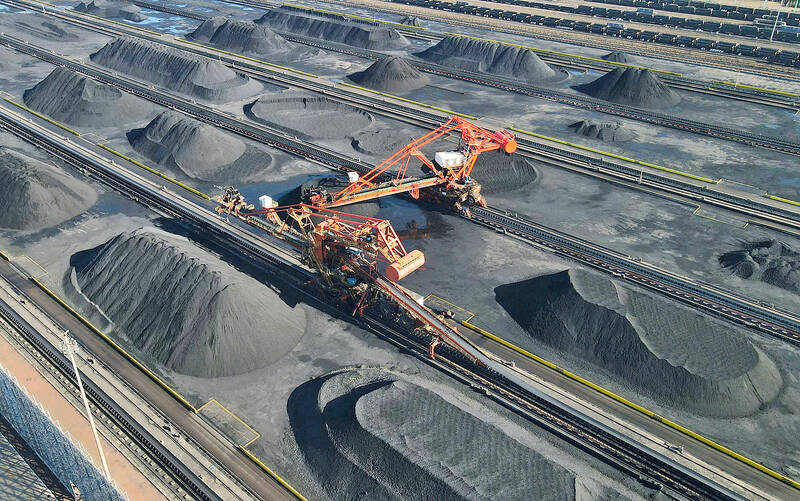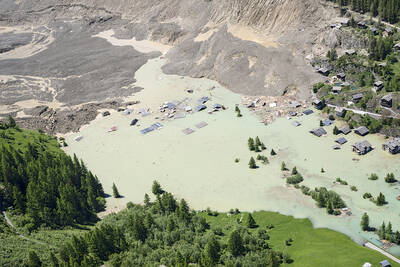China last year approved the largest expansion of coal-fired power plants since 2015, a study published yesterday showed, despite its vow to begin phasing down use of the fossil fuel in three years.
The coal power capacity that China began building last year was six times as much as that in the rest of the world combined, the report by the Centre for Research on Energy and Clean Air (CREA) in Finland and the Global Energy Monitor said.
“China continues to be the glaring exception to the ongoing global decline in coal plant development,” Global Energy Monitor research analyst Flora Champenois said.

Photo: China Daily / handout via Reuters
“The speed at which projects progressed through permitting to construction in 2022 was extraordinary,” she said.
China is one of the world’s biggest emitters of the greenhouse gases driving climate change, such as carbon dioxide.
Chinese President Xi Jinping (習近平) has pledged that China’s carbon emissions would peak between 2026 and 2030, before it reduces them to net zero by 2060, moves seen as essential for keeping global temperature rise well below 2°C.
The report warned that even if Beijing sticks to those commitments, the current coal power expansion would make meeting them “more complicated and costly.”
A total of 106 gigawatts of new coal power projects were approved last year — the equivalent of two large coal plants per week — it said.
Plants accounting for about one-third of that capacity have already begun construction, with some gaining permits, securing financing and breaking ground “within a matter of months.”
“This kind of a process leaves little room for ... consideration of alternatives,” Champenois said.
China relies on coal for nearly 60 percent of its electricity.
Most of the new coal projects have been approved in provinces hit by crippling electricity shortages due to record heat waves in the past two years.
This creates a vicious cycle with increased greenhouse gas emissions accelerating climate change resulting in more frequent extreme weather events, researchers said.
The rush for approvals started after China’s Cabinet in May last year announced 10 billion yuan (US$1.44 billion) of investment in coal power generation.
“This is the same dynamic that we saw during the previous boom in 2015,” CREA lead analyst Lauri Myllyvirta said.
“No one knows how long the floodgates will stay open, so local governments try to rush as many projects through as they can,” she said.
Local officials say that new coal plants would serve as a backup to ensure stable supplies when renewables fail, but provinces such as Guangdong, Jiangsu and Anhui, where the new coal plants are mushrooming, were “laggards” in investing in clean energy to meet demand growth, the study found.
The continued investment in coal “implies insufficient emphasis on overcoming the power system and power market constraints that perpetuate dependence on coal,” it added.
China has ramped up its investments in renewable power including solar, wind, hydro and nuclear plants in the past few years.
If that growth continues to accelerate, the report said, and electricity demand stabilizes, “the massive additions of new coal-fired capacity don’t necessarily mean that coal use or CO2 emissions from the power sector will increase,” the report said.
However, renewable energy projects in China are struggling to get access to land, while in some areas, the grid cannot absorb all the power generated, the head of the China Photovoltaic Industry Association said this month.
The role of coal in ensuring energy security means developing more renewable power does not necessarily lead to a reduced reliance on the fossil fuel, analysts said.
“The biggest misconception is the idea that an increase in renewables will replace coal,” Greenpeace East Asia global policy adviser Li Shuo (李碩) said.
“That is the case with the rest of the world, but China’s need for energy security has led to growth in wind, solar and coal all at the same time,” Li said.

The collapse of the Swiss Birch glacier serves as a chilling warning of the escalating dangers faced by communities worldwide living under the shadow of fragile ice, particularly in Asia, experts said. Footage of the collapse on Wednesday showed a huge cloud of ice and rubble hurtling down the mountainside into the hamlet of Blatten. Swiss Development Cooperation disaster risk reduction adviser Ali Neumann said that while the role of climate change in the case of Blatten “still needs to be investigated,” the wider impacts were clear on the cryosphere — the part of the world covered by frozen water. “Climate change and

Poland is set to hold a presidential runoff election today between two candidates offering starkly different visions for the country’s future. The winner would succeed Polish President Andrzej Duda, a conservative who is finishing his second and final term. The outcome would determine whether Poland embraces a nationalist populist trajectory or pivots more fully toward liberal, pro-European policies. An exit poll by Ipsos would be released when polls close today at 9pm local time, with a margin of error of plus or minus 2 percentage points. Final results are expected tomorrow. Whoever wins can be expected to either help or hinder the

DENIAL: Musk said that the ‘New York Times was lying their ass off,’ after it reported he used so much drugs that he developed bladder problems Elon Musk on Saturday denied a report that he used ketamine and other drugs extensively last year on the US presidential campaign trail. The New York Times on Friday reported that the billionaire adviser to US President Donald Trump used so much ketamine, a powerful anesthetic, that he developed bladder problems. The newspaper said the world’s richest person also took ecstasy and mushrooms, and traveled with a pill box last year, adding that it was not known whether Musk also took drugs while heading the so-called US Department of Government Efficiency (DOGE) after Trump took power in January. In a

It turns out that looming collision between our Milky Way and Andromeda galaxies might not happen after all. Astronomers on Monday said that the probability of the two spiral galaxies colliding is less than previously thought, with a 50-50 chance within the next 10 billion years. That is essentially a coin flip, but still better odds than previous estimates and farther out in time. “As it stands, proclamations of the impending demise of our galaxy seem greatly exaggerated,” the Finnish-led team wrote in a study appearing in Nature Astronomy. While good news for the Milky Way galaxy, the latest forecast might be moot